I’ve tried a lot of different lures in my days on the water, but nothing compares to live bait.
The best live bait for bass will handle most of the presentation, and it’ll draw attention without skepticism from your target bass.
You really can’t go wrong.
The only concern anglers have is choosing the right live bait and knowing how to fish them properly.
Thankfully, it’s so much simpler than you think, and I’m breaking it down for you with my top 10 choices for the best live bait rigs for bass.
Best Live Bait For Bass Fishing
The best live bait for largemouth bass will depend on a few factors.
Your personal fishing habits and technique will play a role, but you’ll also want to consider the specific body of water you’re fishing.
You want to offer the bass the types of live bait they’re used to eating.
If you throw something at them they’ve never seen before, chances are they won’t bite it.
In this YourBassGuy.com Youtube Video, content creator Wesley Littlefield breaks down several live baits worth using!
Minnows
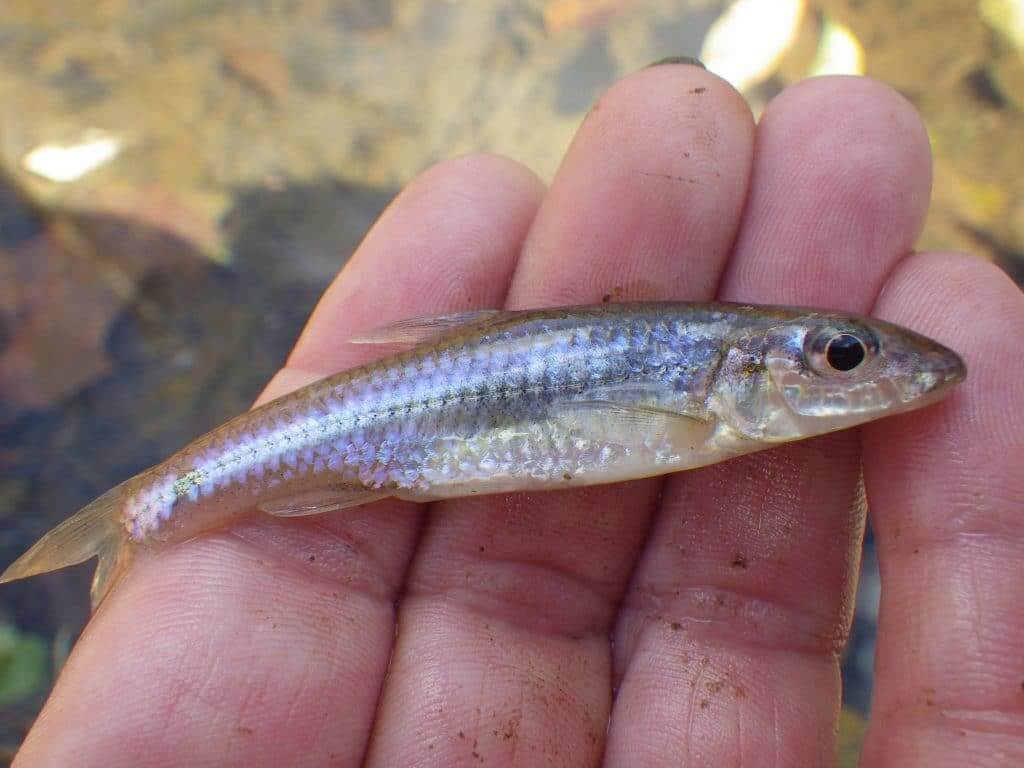
Bigger fish eat smaller fish; that’s the way the food chain works, so use that to your advantage.
Catfish, bass, pike, trout, and others will eat live fish in the water, so you’ll want to determine what they’re eating and make it easy for them to get one by casting it right into their face.
The easiest way to get minnows is by going to a local pro shop and throwing them into a cooler or bait bucket.
If you have a semi-pro bass boat, you might even have a livewell.
If that’s the case, even better.
That said, not all of us have the ability to keep a livewell or even a styrofoam container with water for our minnows, so we need to get creative.
If you don’t have a tackle shop on the way to the lake, you can always catch your own minnows.
Seining is the best strategy for catching minnows.
You’ll want to head to a shallow area along the edge of the lake and use some sight fishing to scope out the ideal area. You should see the silver minnows dotting the area.
Once you find the right spot, take your seine fishing net and sweep it through the shallow water.
Lift the net out, and you should find yourself with some live minnows.
Now you’ll want to sift through them, determine which ones you’re going to keep, and toss the rest back.
When choosing, keep in mind what size bass you’re planning on targeting; the process is the same as if you’re choosing an artificial lure off the shelf.
Umbrella nets work well here, too, and you’ll want to bait them with oatmeal and cat food.
If you’re targeting bigger largemouth, you’ll want to keep the larger minnows.
There’s a variety of methods you can use and a lot of different bait you can throw in there to draw the minnows in, but the little amount of effort is well worth the results you’ll get from dropping the fish the bass are used to eating.
YourBassGuy.com expert minnow-hooker Wesley Littlefield shows us how to properly hook a minnow for the best results in this Youtube video!
Bass Fishing Live Bait with Minnows
The best way to hook a minnow is through both lips from the bottom up.
This method gives it the best presentation, it looks the most natural, and you stand the best chance of limiting the damage you do to the bait in the process of hooking it.
One of the most important things to remember is that live bait doesn’t require a crazy presentation on your end; the only thing you need to worry about is whether or not the bait is alive.
Once the minnow starts slowing down and not moving much, it’s time to replace it with a new one.
My favorite way to fish minnows is with a split shot in the shallow water near dense cover.
You need to keep the rig pretty tight if you’re fishing shallow because you don’t want the minnow drifting too close to the surface because it will appear unnatural.
Another way to do this is with a bobber. In many cases, a bobber will work better because it will keep the baitfish off the bottom of the lake, which will help increase the lifespan of the minnow, and you won’t have to change it out as often.
Shad/Shiners
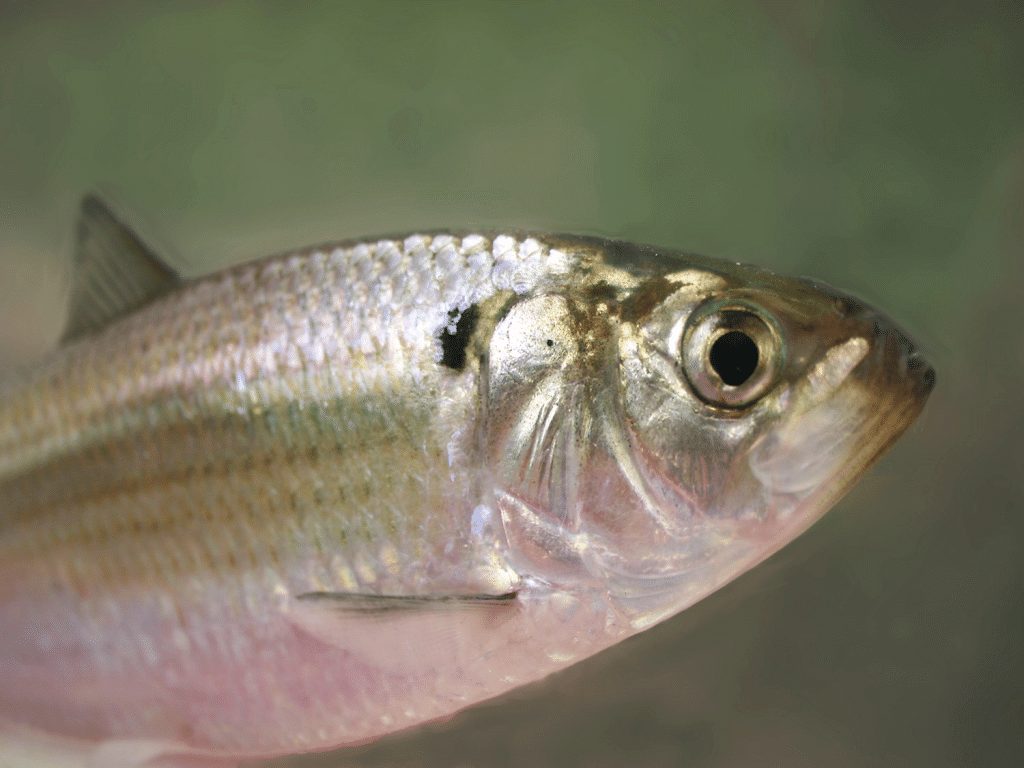
Shad are the best live bait for striped bass, hands down.
If you prefer to target larger bass in deeper water, this is what you need to have at the end of your line.
They work well for big flathead and catfish as well, but you can certainly use them for largemouth too.
If you’re trying to catch shad to use as bait, we’ll deploy a strategy a little different than the one we used for minnows.
It’s a bit more complicated.
You’ll have to use a cast fishing net and venture towards the rocks and dams.
The main difference between a cast net and a seine fishing net is the casting net will be thrown over the side of the boat, and you’ll have to retrieve it later.
This can work in a few different ways.
I recommend having two or three of these, drop them in the most ideal location based on your instinct or what your best fish finder is telling you, then come back around and retrieve them.
One brilliant expert tip is to take a lantern and hang it over the side of the boat at night.
Shad will school up near it, and then you can throw the net out and get all the shad you need.
Fishing With Shad
Fishing shad bait for bass isn’t complicated, and there are a few different methods you can use since you’re typically in more open water than with minnows.
The most popular strategy is drift fishing with a barrel swivel and egg sinker.
You’ll take this and put it at the end of a 36-inch leader and position it a few feet off the bottom.
This strategy works great for stripers, and largemouth will chase it too.
Make sure you’re storing your shad properly in a well-aerated container, and many experts add rock salt to the water because it helps keep the bait active.
Madtoms

If you live in the Southeastern part of the country or near the Gulf, chances are you’ve considered using Madtoms at least once. These are small catfish sometimes known as “stonecats,” but they’re a great option to tempt smallmouth bass.
Bass fishing with live bait is simple when you have something like this, and I’ve found that these are the best live baits for smallmouth bass.
They work well in rivers, but the biggest problem is finding them.
You won’t find these at too many bait shops, so you’ll have to get out there and put in the work yourself.
The only way to catch Madtoms is by throwing on some fishing boots, getting into the water, and turning over rocks.
These baits last a lot longer than minnows and shad, and they’re much bigger, so you won’t have to deal with the smaller bass picking apart your bait while you sit there waiting for the big ones.
Fishing With Madtoms
The most important thing to understand about these baits is that they have venomous spines like a lot of catfish, so you need to be careful when handling them. You’ll want to keep them in a bait bucket, and hooking them is as simple as running a size 2 hook through both of their lips from the bottom.
They’re bottom feeders, so you don’t want to change that. You don’t need a weight, let them sink right to the bottom, and for the most part, the Madtom will do the work for you. If you feel a strike, let the fish run with it for a bit and give it a chance before you set the hook.
I recommend fishing in pools along riverbanks and logjams. Ideally, you want to find anywhere that the current slows down if you’re fishing in a river because this will prevent the Madtom from going right under a rock when you cast it.
Hellgrammites
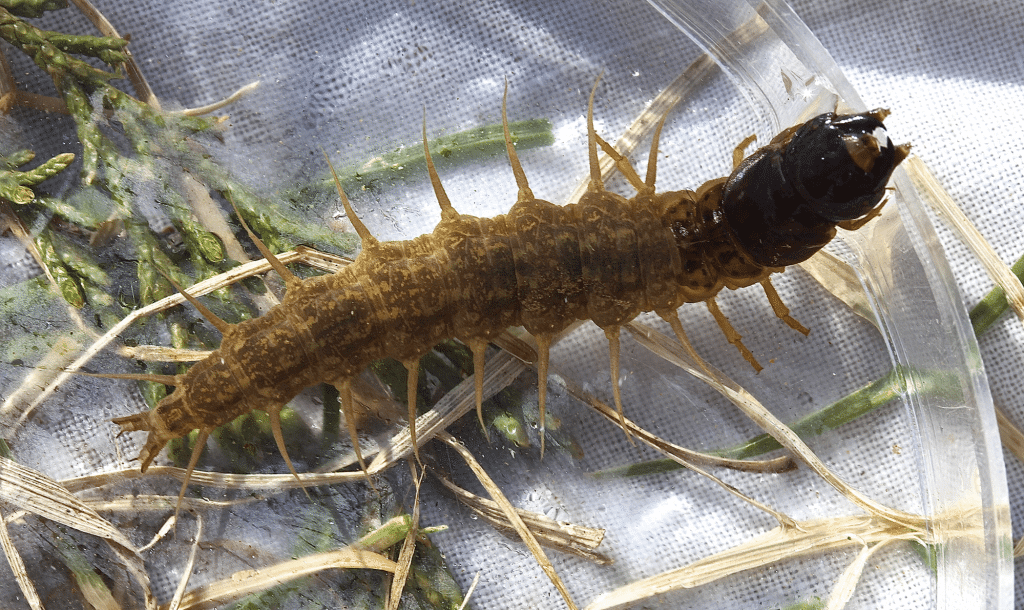
Here’s another rocky living creature that you’ll find in streams and rivers. It’s the larvae of a Dobsonfly, and they come in sizes ranging between one and three inches. These are excellent choices of live bait for both smallmouth and largemouth bass, and you can use them to catch a variety of fish.
To capture them, you’ll have to take the slow and steady approach of turning over rocks until you find them. I’d suggest having two people for this process. One person is there to turn over the rocks, and the other is there with a net ready to capture it when you find one.
The best thing about Hellgrammites is they’re easy to store, and they are low-maintenance. You can keep them alive for weeks if you store them in a container with natural brush and water. Make sure you don’t drown them; Hellgrammites need air just as much as they need water.
Fishing With Hellgrammites
I should also mention that you want to be careful when handling these as well. They have strong jaws that can dig deep into your skin, so you’ll want to hold them with your fingers behind their “collar.” That would be the section of the torso where the legs begin.
The collar is also where you’ll hook them using a fine wire hook. As for the fishing strategy, keep it simple and let the current do the work for you. You can try a bobber, or you could go without, but I recommend using a very small split shot weight just to keep it on the bottom, and you’ll want to fish relatively shallow water with these closest to dense cover. You can use this method to draw the big bass out of hiding.
Crawfish
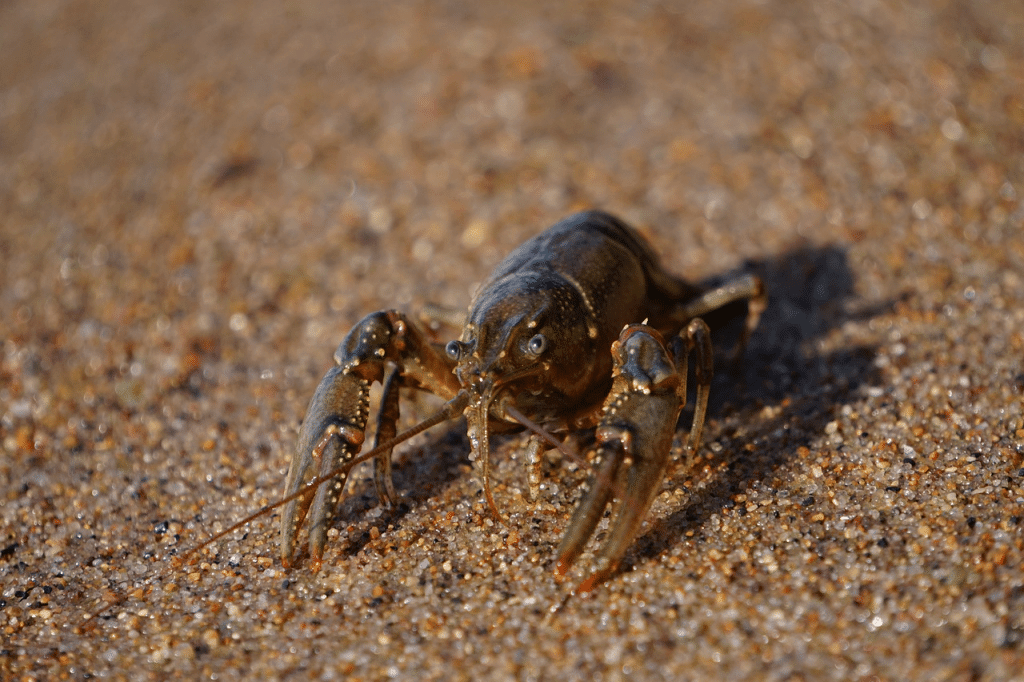
Crawfish, crayfish, crawdads, whatever you call them, they’re the best live bait for largemouth bass, hands down. No bass can resist them, the presentation is always on-point, and they’re delicious.
Best of all, catching them isn’t as hard as you think. It’s obviously not as easy as strolling into a bait shop and buying minnows, but it’s not as hard as finding Hellgrammites and Madtoms.
I’d suggest looking at small streams and start flipping over rocks and logs. You’ll most often find them buried in the mud. You could go purchase a minnow trap and bait it with bread to draw them in as well. Once you find one, you’ll want to hold your net behind it and push it back into the net using a stick or something similar. They’re the easiest to catch but not always the first bait you’ll spot.
Fishing With Crawfish
Now you’ve got a few crustaceans, how do you freshwater fish with them? You’ll want to penetrate the tail with a hook proportionate to the size of the crawfish. The best fishing methods will either be drifting or casting near the rocks.
There isn’t really any unique magical strategy here; all you need to do is drop them in the water and let them do their thing. That’s one of the best parts of live bait bass fishing. The presentation is relatively hands-off.
Night Crawlers
In the YouTube video above, YourBassGuy.com Community Coordinator Wes Littlefield shows us three of his favorite ways to rig a live worm.
Night Crawlers are not hard to find, and bass fishing with live blood worms is one of the simplest ways to approach the game. You should be able to find Night Crawlers at your local bait shop, but if you have kids, it’s a fun activity for them. Send them into the water right along the shore and let them flip over rocks.
You’ll want to get commercial worm bedding and place it in a styrofoam container and keep it in the refrigerator. You can store worms like this for weeks, if not months, so it’s well worth the work.
Fishing With Night Crawlers
If you’re fishing with Night Crawlers, chances are you’ll want to go towards the shallow water and fish with lighter tackle. This method is great for new anglers or kids who are just getting introduced to the sport.
Take an ultralight or light rod, six-pound monofilament, and a split shot and throw the worm on the hook. Rig it through the tip and keep as much of the hook covered but ensure that the barb is protruding enough to set the hook. Depending on where you’re fishing, this strategy might change, but this is what I would use on most occasions.
You’ll pretty much just jig them most of the time and you can use night crawlers to catch an assortment of fish including crappie, walleye, sunfish, other panfish, and big fish alike.
Frogs

Frogs are one of the best live baits for bass and certainly the most underrated. They perform extremely well in dense cover and anywhere you have heavy vegetation. Go out after or during a heavy rainstorm and walk along the side of rural roadways; here, you’ll easily find frogs that you can use to clean up in the water.
I don’t recommend this bass fishing technique for beginners because it does require a bit of experience and finesse once you get the frog hooked, but for bass anglers who understand how to fish in dense vegetation, there’s no better strategy.
Fishing With Frogs
Rigging the frog might seem a little daunting, but it’s not bad if you go through the forelegs. Doing this doesn’t hinder their ability to move, so they can still swim freely and naturally. Use a wide gap hook and a split shot about one foot away from the hook.
Toss the frog over the side of your boat near bass cover, lily pads, and anything else you can find. They’ll usually swim right to the bottom and should immediately draw attention. If you’re not getting any takers, give the quick jerk on the rod tip, and that should get the frog going erratically, which will get more attention from neighboring bass.
Salamanders
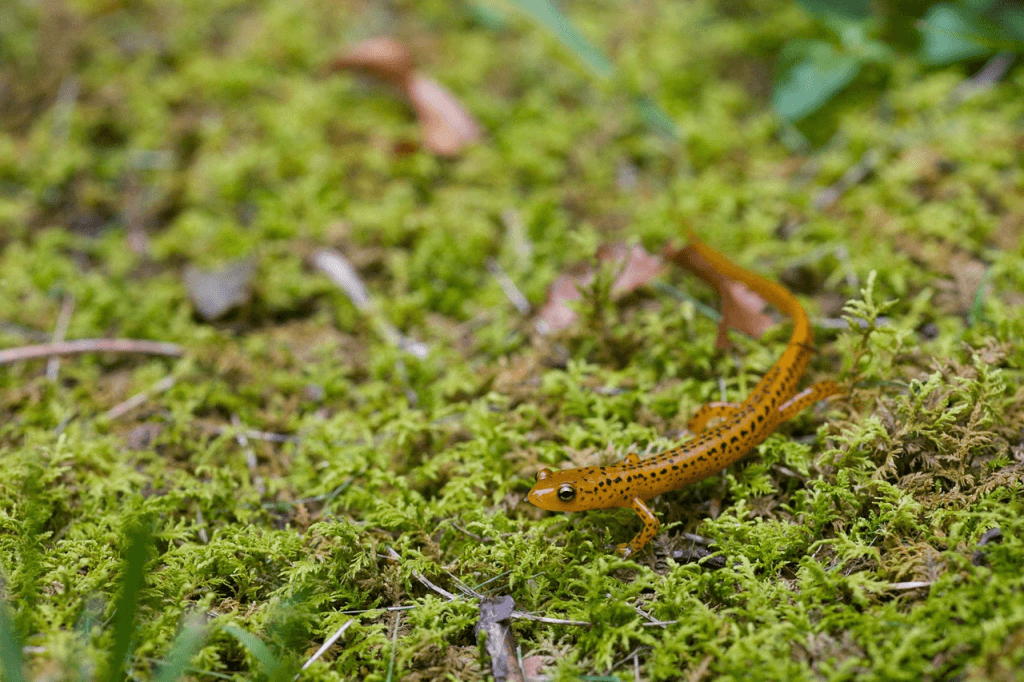
Salamanders are another overlooked bass live bait. You can find these at local tackle shops, but you should understand that you can’t use just any salamanders. What you’re looking for is the aquatic type known as “water dogs.” These have the appearance of a tadpole, which is a common food for bass of all types.
Collecting these yourself is borderline impossible, so you’ll have to find a place to buy them, and the pro shop should also provide you with a way to keep them.
Fishing With Salamanders
You’ll want to run your hook through the nostrils or the tail and use a sinker approximately two feet from the hook. Instead of casting or drifting, simply drop the salamander into the water and release your line. Let it fall to the bottom and work its magic from there.
If you’re not getting much, you can slowly troll your boat, but I really mean slowly. If you go too fast, you’ll be taking control of the presentation instead of letting the live bait do what it does best.
Bluegills

Bluegills are great for live bait bass fishing for a few reasons. One, they’re easy to find. Two, they keep easily on the side of your boat. Three, bass are naturally attracted to them, and they create their own presentation, so it’s a no-brainer, really.
The best way to put together a portfolio of bluegill is to catch them yourself. Make sure you’re using light tackle because you want to catch small bluegill, and you’re not looking to attract anything else right now.
Fishing With Bluegill
Once you’re done with “for” bluegill, you’ll want to fish “with” them. Bluegill are highly attractive to bass, and you’ll want to rig them with both a split shot and a bobber and fish them suspended. Make sure your split shot is a good distance from the hook (approximately two feet) depending on the depth of the water.
You’ll want to drop them in and troll with your boat slowly to create the presentation. The slower, the better.
Mice
Bass eating mice is a real thing, but it’s a bit of a challenge to rig them and fish them properly. While you could do it, I don’t really recommend it because rigging them is brutal, and you can only fish them in shallow water, so you’ll need to find ones small enough, which can get pretty expensive unless you’re catching your own mice.
If you’re thinking of fishing mice, I would suggest going with an artificial lure that looks like one. They make artificials that look like mice, topwater frogs, snakes, and more. Live bait works in many situations but it isn’t always the better choice.
Crankbaits, plastic worms, spinnerbaits, and other artificial fishing lures work just fine if that’s your game!
Final Thoughts
The best live bait for bass is really subjective to the individual. If I had to pick a live bait, I would go with night crawlers. I think they’re the simplest option, they’re affordable, and they’re easy to fish. If you’re looking to branch out, shad and minnows are solid as well, and frogs work well if you know what you’re doing.
Don’t be afraid to experiment! Good luck!
yourbassguy.comI’ve tried a lot of different lures in my days on the water, but nothing compares to live bait.
The best live bait for bass will handle most of the presentation, and it’ll draw attention without skepticism from your target bass.
You really can’t go wrong.
The only concern anglers have is choosing the right live bait and knowing how to fish them properly.
Thankfully, it’s so much simpler than you think, and I’m breaking it down for you with my top 10 choices for the best live bait rigs for bass.
Best Live Bait For Bass Fishing
The best live bait for largemouth bass will depend on a few factors.
Your personal fishing habits and technique will play a role, but you’ll also want to consider the specific body of water you’re fishing.
You want to offer the bass the types of live bait they’re used to eating.
If you throw something at them they’ve never seen before, chances are they won’t bite it.
In this YourBassGuy.com Youtube Video, content creator Wesley Littlefield breaks down several live baits worth using!
Minnows

Bigger fish eat smaller fish; that’s the way the food chain works, so use that to your advantage.
Catfish, bass, pike, trout, and others will eat live fish in the water, so you’ll want to determine what they’re eating and make it easy for them to get one by casting it right into their face.
The easiest way to get minnows is by going to a local pro shop and throwing them into a cooler or bait bucket.
If you have a semi-pro bass boat, you might even have a livewell.
If that’s the case, even better.
That said, not all of us have the ability to keep a livewell or even a styrofoam container with water for our minnows, so we need to get creative.
If you don’t have a tackle shop on the way to the lake, you can always catch your own minnows.
Seining is the best strategy for catching minnows.
You’ll want to head to a shallow area along the edge of the lake and use some sight fishing to scope out the ideal area. You should see the silver minnows dotting the area.
Once you find the right spot, take your seine fishing net and sweep it through the shallow water.
Lift the net out, and you should find yourself with some live minnows.
Now you’ll want to sift through them, determine which ones you’re going to keep, and toss the rest back.
When choosing, keep in mind what size bass you’re planning on targeting; the process is the same as if you’re choosing an artificial lure off the shelf.
Umbrella nets work well here, too, and you’ll want to bait them with oatmeal and cat food.
If you’re targeting bigger largemouth, you’ll want to keep the larger minnows.
There’s a variety of methods you can use and a lot of different bait you can throw in there to draw the minnows in, but the little amount of effort is well worth the results you’ll get from dropping the fish the bass are used to eating.
YourBassGuy.com expert minnow-hooker Wesley Littlefield shows us how to properly hook a minnow for the best results in this Youtube video!
Bass Fishing Live Bait with Minnows
The best way to hook a minnow is through both lips from the bottom up.
This method gives it the best presentation, it looks the most natural, and you stand the best chance of limiting the damage you do to the bait in the process of hooking it.
One of the most important things to remember is that live bait doesn’t require a crazy presentation on your end; the only thing you need to worry about is whether or not the bait is alive.
Once the minnow starts slowing down and not moving much, it’s time to replace it with a new one.
My favorite way to fish minnows is with a split shot in the shallow water near dense cover.
You need to keep the rig pretty tight if you’re fishing shallow because you don’t want the minnow drifting too close to the surface because it will appear unnatural.
Another way to do this is with a bobber. In many cases, a bobber will work better because it will keep the baitfish off the bottom of the lake, which will help increase the lifespan of the minnow, and you won’t have to change it out as often.
Shad/Shiners

Shad are the best live bait for striped bass, hands down.
If you prefer to target larger bass in deeper water, this is what you need to have at the end of your line.
They work well for big flathead and catfish as well, but you can certainly use them for largemouth too.
If you’re trying to catch shad to use as bait, we’ll deploy a strategy a little different than the one we used for minnows.
It’s a bit more complicated.
You’ll have to use a cast fishing net and venture towards the rocks and dams.
The main difference between a cast net and a seine fishing net is the casting net will be thrown over the side of the boat, and you’ll have to retrieve it later.
This can work in a few different ways.
I recommend having two or three of these, drop them in the most ideal location based on your instinct or what your best fish finder is telling you, then come back around and retrieve them.
One brilliant expert tip is to take a lantern and hang it over the side of the boat at night.
Shad will school up near it, and then you can throw the net out and get all the shad you need.
Fishing With Shad
Fishing shad bait for bass isn’t complicated, and there are a few different methods you can use since you’re typically in more open water than with minnows.
The most popular strategy is drift fishing with a barrel swivel and egg sinker.
You’ll take this and put it at the end of a 36-inch leader and position it a few feet off the bottom.
This strategy works great for stripers, and largemouth will chase it too.
Make sure you’re storing your shad properly in a well-aerated container, and many experts add rock salt to the water because it helps keep the bait active.
Madtoms

If you live in the Southeastern part of the country or near the Gulf, chances are you’ve considered using Madtoms at least once. These are small catfish sometimes known as “stonecats,” but they’re a great option to tempt smallmouth bass.
Bass fishing with live bait is simple when you have something like this, and I’ve found that these are the best live baits for smallmouth bass.
They work well in rivers, but the biggest problem is finding them.
You won’t find these at too many bait shops, so you’ll have to get out there and put in the work yourself.
The only way to catch Madtoms is by throwing on some fishing boots, getting into the water, and turning over rocks.
These baits last a lot longer than minnows and shad, and they’re much bigger, so you won’t have to deal with the smaller bass picking apart your bait while you sit there waiting for the big ones.
Fishing With Madtoms
The most important thing to understand about these baits is that they have venomous spines like a lot of catfish, so you need to be careful when handling them. You’ll want to keep them in a bait bucket, and hooking them is as simple as running a size 2 hook through both of their lips from the bottom.
They’re bottom feeders, so you don’t want to change that. You don’t need a weight, let them sink right to the bottom, and for the most part, the Madtom will do the work for you. If you feel a strike, let the fish run with it for a bit and give it a chance before you set the hook.
I recommend fishing in pools along riverbanks and logjams. Ideally, you want to find anywhere that the current slows down if you’re fishing in a river because this will prevent the Madtom from going right under a rock when you cast it.
Hellgrammites

Here’s another rocky living creature that you’ll find in streams and rivers. It’s the larvae of a Dobsonfly, and they come in sizes ranging between one and three inches. These are excellent choices of live bait for both smallmouth and largemouth bass, and you can use them to catch a variety of fish.
To capture them, you’ll have to take the slow and steady approach of turning over rocks until you find them. I’d suggest having two people for this process. One person is there to turn over the rocks, and the other is there with a net ready to capture it when you find one.
The best thing about Hellgrammites is they’re easy to store, and they are low-maintenance. You can keep them alive for weeks if you store them in a container with natural brush and water. Make sure you don’t drown them; Hellgrammites need air just as much as they need water.
Fishing With Hellgrammites
I should also mention that you want to be careful when handling these as well. They have strong jaws that can dig deep into your skin, so you’ll want to hold them with your fingers behind their “collar.” That would be the section of the torso where the legs begin.
The collar is also where you’ll hook them using a fine wire hook. As for the fishing strategy, keep it simple and let the current do the work for you. You can try a bobber, or you could go without, but I recommend using a very small split shot weight just to keep it on the bottom, and you’ll want to fish relatively shallow water with these closest to dense cover. You can use this method to draw the big bass out of hiding.
Crawfish

Crawfish, crayfish, crawdads, whatever you call them, they’re the best live bait for largemouth bass, hands down. No bass can resist them, the presentation is always on-point, and they’re delicious.
Best of all, catching them isn’t as hard as you think. It’s obviously not as easy as strolling into a bait shop and buying minnows, but it’s not as hard as finding Hellgrammites and Madtoms.
I’d suggest looking at small streams and start flipping over rocks and logs. You’ll most often find them buried in the mud. You could go purchase a minnow trap and bait it with bread to draw them in as well. Once you find one, you’ll want to hold your net behind it and push it back into the net using a stick or something similar. They’re the easiest to catch but not always the first bait you’ll spot.
Fishing With Crawfish
Now you’ve got a few crustaceans, how do you freshwater fish with them? You’ll want to penetrate the tail with a hook proportionate to the size of the crawfish. The best fishing methods will either be drifting or casting near the rocks.
There isn’t really any unique magical strategy here; all you need to do is drop them in the water and let them do their thing. That’s one of the best parts of live bait bass fishing. The presentation is relatively hands-off.
Night Crawlers
In the YouTube video above, YourBassGuy.com Community Coordinator Wes Littlefield shows us three of his favorite ways to rig a live worm.
Night Crawlers are not hard to find, and bass fishing with live blood worms is one of the simplest ways to approach the game. You should be able to find Night Crawlers at your local bait shop, but if you have kids, it’s a fun activity for them. Send them into the water right along the shore and let them flip over rocks.
You’ll want to get commercial worm bedding and place it in a styrofoam container and keep it in the refrigerator. You can store worms like this for weeks, if not months, so it’s well worth the work.
Fishing With Night Crawlers
If you’re fishing with Night Crawlers, chances are you’ll want to go towards the shallow water and fish with lighter tackle. This method is great for new anglers or kids who are just getting introduced to the sport.
Take an ultralight or light rod, six-pound monofilament, and a split shot and throw the worm on the hook. Rig it through the tip and keep as much of the hook covered but ensure that the barb is protruding enough to set the hook. Depending on where you’re fishing, this strategy might change, but this is what I would use on most occasions.
You’ll pretty much just jig them most of the time and you can use night crawlers to catch an assortment of fish including crappie, walleye, sunfish, other panfish, and big fish alike.
Frogs

Frogs are one of the best live baits for bass and certainly the most underrated. They perform extremely well in dense cover and anywhere you have heavy vegetation. Go out after or during a heavy rainstorm and walk along the side of rural roadways; here, you’ll easily find frogs that you can use to clean up in the water.
I don’t recommend this bass fishing technique for beginners because it does require a bit of experience and finesse once you get the frog hooked, but for bass anglers who understand how to fish in dense vegetation, there’s no better strategy.
Fishing With Frogs
Rigging the frog might seem a little daunting, but it’s not bad if you go through the forelegs. Doing this doesn’t hinder their ability to move, so they can still swim freely and naturally. Use a wide gap hook and a split shot about one foot away from the hook.
Toss the frog over the side of your boat near bass cover, lily pads, and anything else you can find. They’ll usually swim right to the bottom and should immediately draw attention. If you’re not getting any takers, give the quick jerk on the rod tip, and that should get the frog going erratically, which will get more attention from neighboring bass.
Salamanders

Salamanders are another overlooked bass live bait. You can find these at local tackle shops, but you should understand that you can’t use just any salamanders. What you’re looking for is the aquatic type known as “water dogs.” These have the appearance of a tadpole, which is a common food for bass of all types.
Collecting these yourself is borderline impossible, so you’ll have to find a place to buy them, and the pro shop should also provide you with a way to keep them.
Fishing With Salamanders
You’ll want to run your hook through the nostrils or the tail and use a sinker approximately two feet from the hook. Instead of casting or drifting, simply drop the salamander into the water and release your line. Let it fall to the bottom and work its magic from there.
If you’re not getting much, you can slowly troll your boat, but I really mean slowly. If you go too fast, you’ll be taking control of the presentation instead of letting the live bait do what it does best.
Bluegills

Bluegills are great for live bait bass fishing for a few reasons. One, they’re easy to find. Two, they keep easily on the side of your boat. Three, bass are naturally attracted to them, and they create their own presentation, so it’s a no-brainer, really.
The best way to put together a portfolio of bluegill is to catch them yourself. Make sure you’re using light tackle because you want to catch small bluegill, and you’re not looking to attract anything else right now.
Fishing With Bluegill
Once you’re done with “for” bluegill, you’ll want to fish “with” them. Bluegill are highly attractive to bass, and you’ll want to rig them with both a split shot and a bobber and fish them suspended. Make sure your split shot is a good distance from the hook (approximately two feet) depending on the depth of the water.
You’ll want to drop them in and troll with your boat slowly to create the presentation. The slower, the better.
Mice
Bass eating mice is a real thing, but it’s a bit of a challenge to rig them and fish them properly. While you could do it, I don’t really recommend it because rigging them is brutal, and you can only fish them in shallow water, so you’ll need to find ones small enough, which can get pretty expensive unless you’re catching your own mice.
If you’re thinking of fishing mice, I would suggest going with an artificial lure that looks like one. They make artificials that look like mice, topwater frogs, snakes, and more. Live bait works in many situations but it isn’t always the better choice.
Crankbaits, plastic worms, spinnerbaits, and other artificial fishing lures work just fine if that’s your game!
Final Thoughts
The best live bait for bass is really subjective to the individual. If I had to pick a live bait, I would go with night crawlers. I think they’re the simplest option, they’re affordable, and they’re easy to fish. If you’re looking to branch out, shad and minnows are solid as well, and frogs work well if you know what you’re doing.
Don’t be afraid to experiment! Good luck!


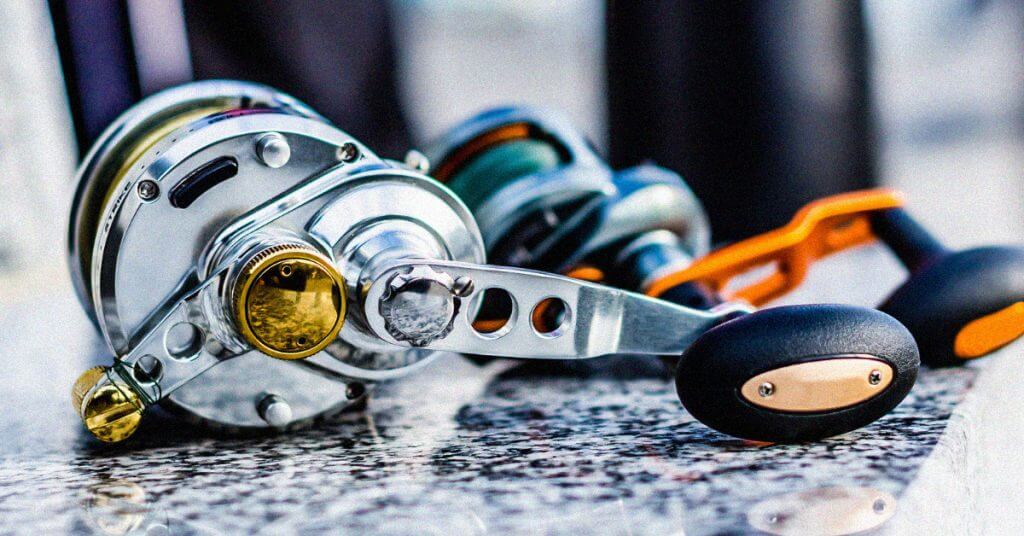
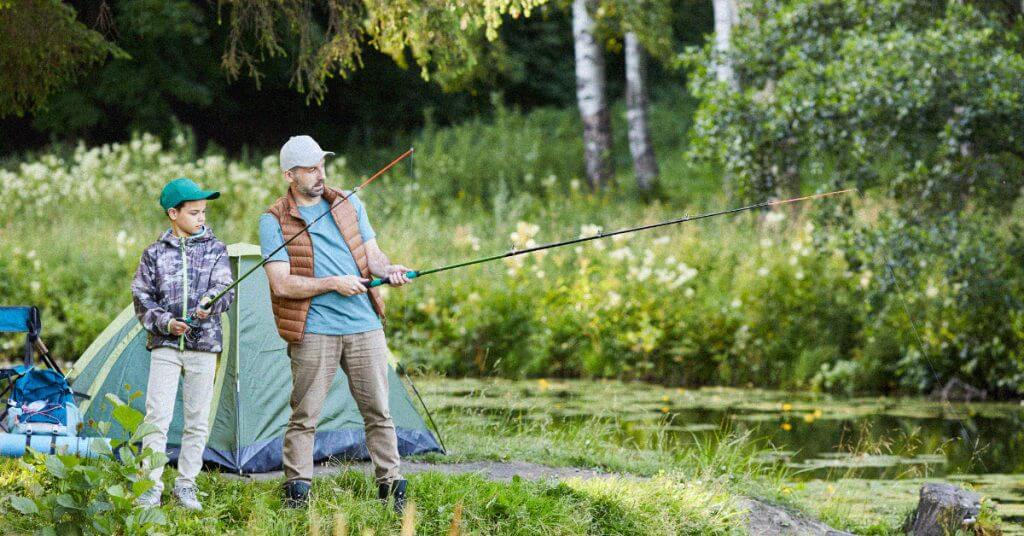
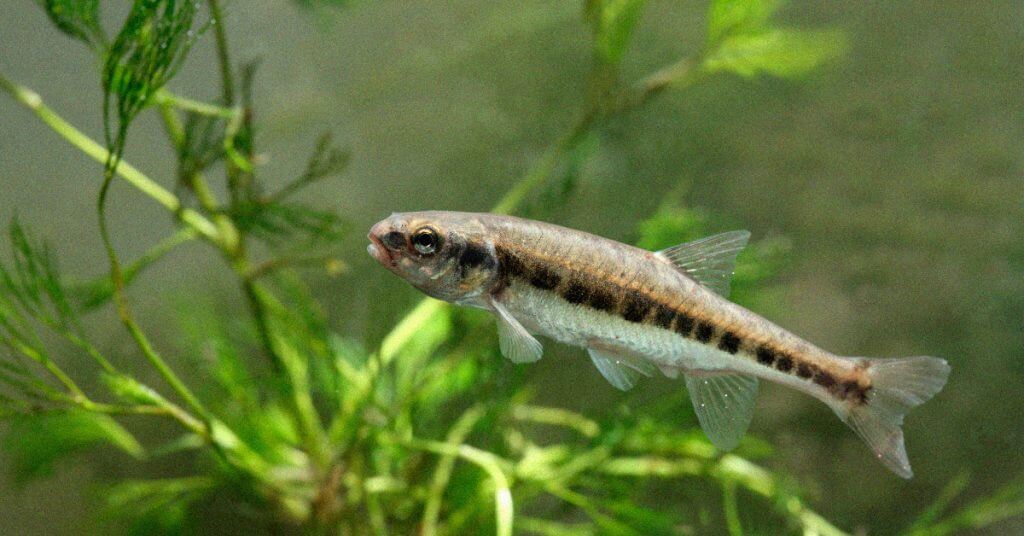
Thanks for a great deal of information
Thanks for reading Greg!
Catfish are NOT poisonous… Lol… Get educated before your next article you write ✍️
Your comment here is not constructive at all. It’s one thing to ask for proof, and another to just insult our writers.
Take a look at this study by the University of Michigan: https://news.umich.edu/killer-catfish-venomous-species-surprisingly-common-study-finds/ – which clearly states “A new study by University of Michigan graduate student Jeremy Wright finds that at least 1,250 and possibly more than 1,600 species of catfish may be venomous, far more than previously believed.
Or perhaps this Abstract by the National Library of Medicine: https://pubmed.ncbi.nlm.nih.gov/2022846/ which clearly states “Catfish skin toxin and the venom from their dorsal and pectoral spines may cause a menacing sting. Although these stings are often innocuous, severe tissue necrosis may occur. The hand is the most common site of catfish stings.
Some catfish do have slightly poisonous fins. However, i think there is more of a chance of getting a bacterial infection from being stuck, than actually being poisoned. I had an uncle that got injected by a slightly toxic catfish fin, which hospitalized him (temporarily) with fever, stomach issues, and flu-like symptoms. An admitting physician from the ER he had gone to, informed him of toxins / poisons being stored in catfish fins, which caused his illness, due to being stuck. It is likely a rare occurrence, and not typical, but it not mythical.
Good tips and article!
Thanks for the kind words and stopping by!
Come back sometime 🙂